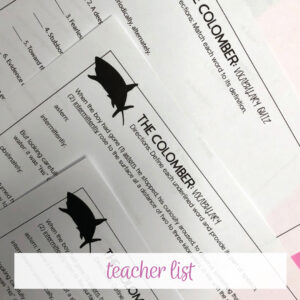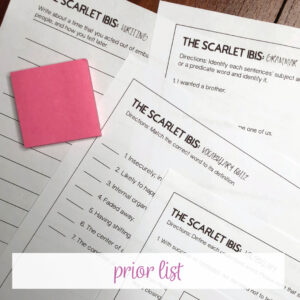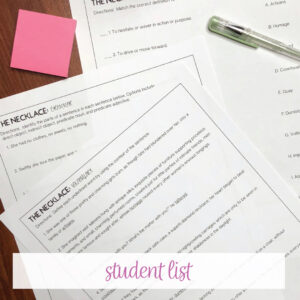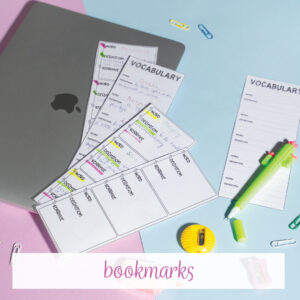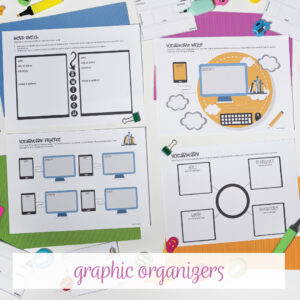Looking for ways to create a vocabulary list, specifically a vocabulary list for secondary students? These methods should give you a starting point.
Vocabulary instruction needs constant tweaking in my experiences. Whatever we read, my students and I develop a different list through every new reading. Our terms are different every year.
Why? Each class possesses its own community, and each class wishes to explore different words in different ways. Vocabulary creates an opportunity for student choice and contributes to a classroom community that cares about personalized educational goals.
This post isn’t about vocabulary activities, but instead addresses ways to create a vocabulary list. Use one of these methods or a combination! When you consider how to make a vocabulary list, try. . .
Creating a Teacher-List
In a perfect world, this might be unnecessary. With difficult texts, guiding students with vocabulary words helps. As you prep for teaching, compile terms to study.
For instance, I’ve taught The Jungle, and at first, I asked students to find words to define. Unfortunately, they developed lists of about 30 words, per chapter. Combined with learning about a strange time period and a different culture, they were overwhelmed. I wanted them to succeed with the book, not hate it. When I thought about how to organize vocabulary for The Jungle, the answer was for the teacher to choose a few terms that would clarify the reading.
I chose the list of vocabulary words that would help them understand the content, and I defined the words. We did not study vocabulary with every chapter, but I often clarified terms while reading or reviewing. Sometimes, young readers need you to take something off their plates. Give them the vocabulary list, and let them focus on a unique aspect of the story.
If students spend more time on vocabulary than reading, I give them a list that I created.
Building on a Prior List
Many short stories have words identified and defined (in textbooks). When creating a vocabulary list, I use those words as a basis and ask my readers to add words. Typically, I give them a number, but I normally just ask them to find unfamiliar words.
Another twist is to start with the prior list and assign students to find five (or so) more words. Then, brainstorm the student-gathered words as a class. (You can download one of my vocabulary lists.) Write all the terms that students identified and discuss their meanings together. Compile the most commonly found words and complete an extension activity with those. A perfect extension activity is to create a word wall together for additional studying. The goal is to have students engage with the material in a variety of ways.
You’ve built on the prior list, and classes contributed—the best of both situations.
Encouraging Student Lists
Teenagers’ involvement with the vocabulary list for secondary students matters. When students create the vocabulary list, teachers have the most work. When the story and class tone lends itself, allow a self-generated vocabulary list for secondary students.
You must check that students have not chosen obvious words and that they have defined them correctly. They may use the wrong form or definition. You must check that everyone did not copy and paste one list. (Lots of work, but a big pay-off.)
If all students identify unfamiliar words as they read, they will be invested in understanding the reading material and the words. You can then again provide student choice in how they practice for a truly student-directed learning opportunity. This method particularly works well if you need to focus on buy-in.
Using Bookmarks
Provide students with bookmarks for their reading assignments. As they read, they can jot down words for learning. Then, collect their bookmarks for a new list of words to discuss as a class. This method allows students to actively engage with the text and take ownership of their learning.
Because older classes appreciate options, my bookmarks allows readers to note words in different ways, hopefully, ways that make sense to each individual.
Utilizing Graphic Organizers
Graphic organizers allow classes to create, explore, and collaborate as they explore new terms. Vocabulary graphic organizers provide a structured framework for learners to organize and connect new words. They help students visualize the relationships between words, making it easier to understand and remember them.
One effective graphic organizer is the semantic web. Students can create a web by writing a new word in the center and connecting related words around it. This encourages them to think about synonyms, antonyms, word families, and other associations.
Another useful graphic organizer is the Frayer model. It consists of four sections: definition, characteristics, examples, and non-examples. By filling out each section for a new word, students gain a deeper understanding of the term’s meaning.
What do I do after I create a vocabulary list?
You have your list, great! Now, you and your classes must do something with the terms, something more than a boring quiz.
First, a gallery walk is a great way to engage learners. If students use graphic organizers, ask each one to produce the best organizer to display. Learners then rotate around the room, engaging with their peers’ approaches to understanding terms.
Second, add a connection to another subject like social studies. For instance, the word “globalization” is mentioned with the study of postmodernism, but it also has connections to other classes.
Another way to encourage student involvement is by incorporating technology. Have everyone use online resources or apps to create. This practice not only enhances their digital literacy skills but also provides them with a sense of autonomy in their learning process.
To further enhance student engagement, consider incorporating games and activities into vocabulary practice. For example, you can organize a charades game where students act out the meaning of a word while others guess. This activity not only makes learning fun but also reinforces word use.
Go create a vocabulary list!
No matter what method you choose now, continue to modify and adjust so that your classes see the value in studying new words. Don’t forget to download my editable and free vocabulary list to get started.
Now that you have your vocabulary list for secondary students, read Melissa’s post at The Reading and Writing Haven about brain-based vocabulary activities for the classroom.

How to create a vocabulary list with meaning? I hope these approaches for connecting vocabulary to grammar and literature with secondary students helped. If you’d like to discuss how to organize vocabulary words with other teachers, please join our Facebook Group for collaboration.


